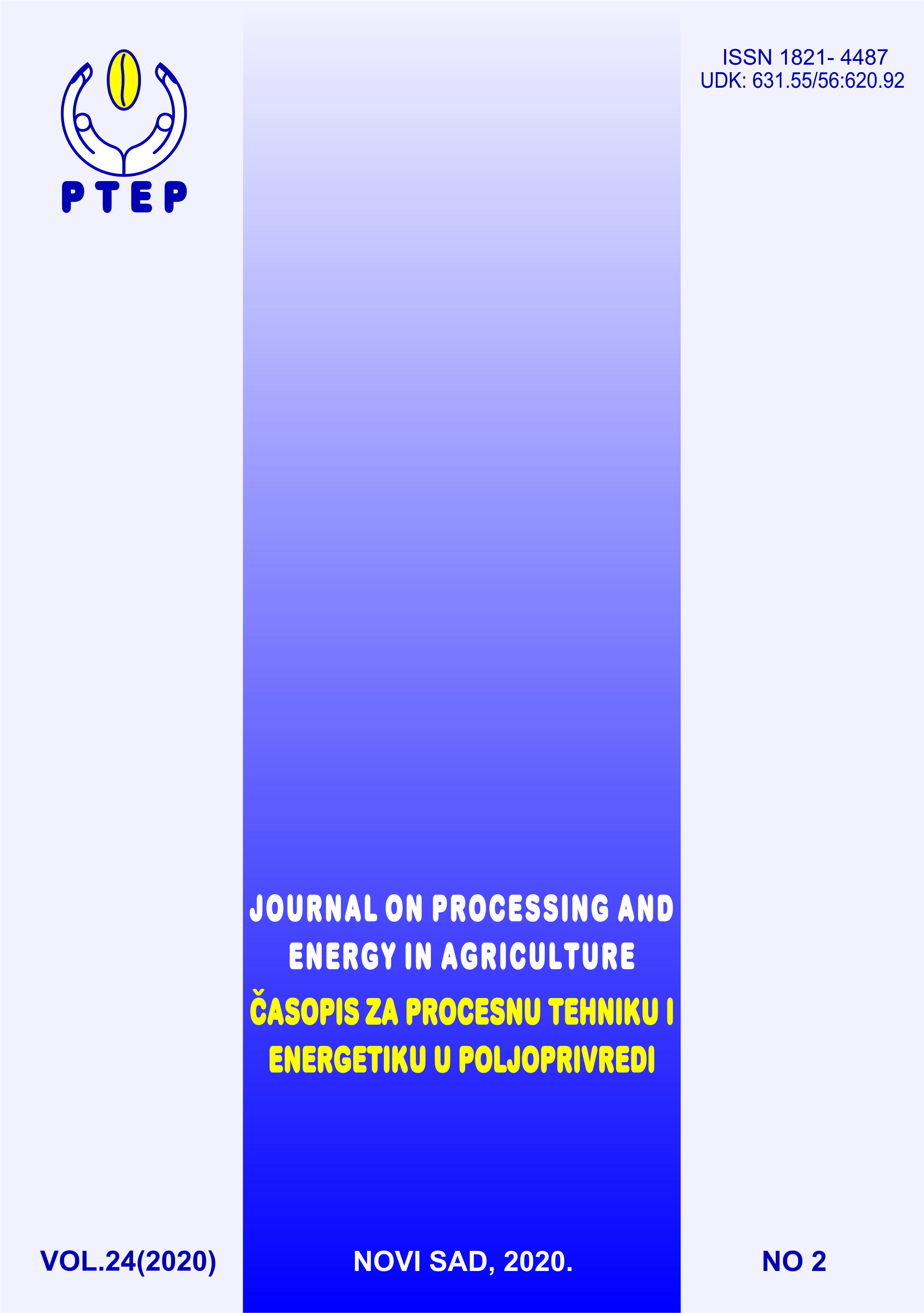POTENTIAL OF Bacillus spp. ANTAGONISTS FOR SUPPRESSION OF Xanthomonas euvesicatoria PHYTOPATHOGENS
Abstract
Bacterial pathogens Xanthomonas euvesicatoria, principal causers of bacterial spot, represent significant problem in agricultural practice due to high yield losses in production of pepper and tomato. Development of resistance to copper pesticides has shifted research in the field of their suppression towards biopesticides. In this study, several Bacillus strains were tested to select antagonist sufficiently effective against Xanthomonas euvesicatoria strains, isolated from pepper leaves with symptoms of bacterial spot. When it comes to testing of cultivation broth, containing biomass of tested antagonists, the best results were achieved using isolate Bacillus sp3. On the other hand, when biomass-free supernatants, containing produced antimicrobial compounds, were tested, Bacillus sp1 and Bacillus sp2 have showed the highest antimicrobial activity. The results of this study represent a basis for further development of bioprocess solutions for production of biopesticides based on Bacillus spp. biomass or antimicrobial compounds, showing high efficiency in suppression of pepper bacterial spot.
References
Buonaurio, R., Scarponi, L., Ferrara, M., Sidoti, P., Bertona, A. (2002). Induction of systemic acquired resistance in pepper plants by acibenzolar-S-methyl against bacterial spot disease. European Journal of Plant Pathology, 108, 41-49.
De Vos, P., Garrity, G.M., Jones, D., Krieg, N.R., Ludwig, W., Rainey, F.A., Schleifer, K.-H., Whitman, W.B. (Eds.) (2009). Bergey’s Manual of Systematic Bacteriology, 2nd Edition, Volume 3. Springer Science+Business Media, LLC, New York, USA.
Earl, A.M., Losick, R., Kolter, R. (2008). Ecology and genomics of Bacillus subtilis. Trends in Microbiology, 16, 269-275.
EPPO (2013). PM 7/110 (1) Xanthomonas spp. (Xanthomonas euvesicatoria, Xanthomonas gardneri, Xanthomonas perforans, Xanthomonas vesicatoria) causing bacterial spot of tomato and sweet pepper. OEPP/EPPO Bulletin, 43, 7–20.
Fira, Đ., Dimkić, I., Berić, T., Lozo, J., Stanković, S. (2018). Biological control of plant pathogens by Bacillus species. Journal of Biotechnology, 285, 44-55.
Gao, H., Li, P., Xu, X., Zeng, Q., Guan, W. (2018). Research on volatile organic compounds from Bacillus subtilis CF-3: biocontrol effects on fruit fungal pathogens and dynamic changes during fermentation. Frontiers in Microbiology, 9, 456.
Gašić, K., Kuzmanović, N., Ivanović, M., Prokić, A., Šević, M., Obradović, A. (2018). Complete genome of the Xanthomonas euvesicatoria specific bacteriophage KΦ1, its survival and potential in control of pepper bacterial spot. Frontiers in Microbiology, 9, 2021.
Köhl, J., Kolnaar, R., Ravensberg, W. (2019). Mode of action of microbial biological control agents against plant diseases: relevance beyond efficacy. Frontiers in Plant Science, 10, 845.
Mansfield, J., Genin, S., Magori, S., Citovsky, V., Sriariyanum, M., Ronald, P., Dow, M., Verdier, V., Beer, S.V., Machado, M.A., Toth, I., Salmond, G., Foster, G.D. (2012). Top 10 plant pathogenic bacteria in molecular plant pathology. Molecular Plant Pathology, 13, 614-629.
Microsoft® Excel 2010 software, v. 2010 (2010). MS Office, Microsoft Corporaton, USA (https://office.com/).
Moretti, C., Amatulli, M.T., Buonaurio, R. (2009). PCR-based assay for the detection of Xanthomonas euvesicatoria causing pepper and tomato bacterial spot. Applied Microbiology, 49, 466-471.
Mota, M.S., Gomes, C.B., Souza Júnior, I.T., Moura, A.B. (2017). Bacterial selection for biological control of plant disease: criterion determination and validation. Brazilian Journal of Microbiology, 48, 62-70.
Ongena, M., Jacques, P. (2008). Bacillus lipopeptides: versatile weapons for plant disease biocontrol. Trends in Microbiology, 16, 115-125.
Pajčin, I., Rončević, Z., Dodić, J., Dodić, S., Jokić, A., Grahovac, J. (2018). Production of biocontrol agents using Bacillus sp. in a laboratory scale bioreactor. Journal on Processing and Energy in Agriculture, 22, 138-142.
Potnis, N., Timilsina, S., Strayer, A., Shantharaj, D., Barak, J.D., Paret, M.L., Vallad, G.E., Jones, J.B. (2015). Bacterial spot of tomato and pepper: diverse Xanthomonas species with a wide variety of virulence factors posing a worldwide challenge. Molecular Plant Pathology, 16, 907-920.
Shafi, J., Tian, H., Ji, M. (2017). Bacillus species as versatile weapons for plant pathogens: a review. Biotechnology & Biotechnological Equipment, 31, 446-459.
Stamenković Stojanović, S., Karabegović, I., Beškoski, V., Nikolić, N., Lazić, M. (2019). Bacillus based microbial formulations: Optimization of the production process. Hemijska Industrija, 73, 169-182.
STATISTICA (Data Analysis Software System), v. 13.5 (2018). Tibco Software Inc., USA
(https://www.tibco.com/).
Stein, T. (2005). Bacillus subtilis antibiotics: structures, syntheses and specific functions. Molecular Microbiology, 56, 845-857.
Sundin, G.W., Castiblanco, L.F., Yuan, X., Zeng, Q., Yang, C.-H. (2016). Bacterial disease management: challenges, experience, innovation and future prospects. Molecular Plant Pathology, 17, 1506-1518.
Sundin, G.W., Wang, N. (2018). Antibiotic resistance in plant-pathogenic bacteria. Annual Review of Phytopathology, 56, 161-180.
Šević, M., Gašić, K., Ignjatov, M., Mijatović, M., Prokić, A., Obradović, A. (2019). Integration of biological and conventional treatments in control of pepper bacterial spot. Crop Protection, 119, 45-51.
Šević, M., Gašić, K., Đorđevic, M., Ignjatov, M., Mijatović, M., Zečević, B., Obradović, A. (2016). Efficacy of biocontrol agents and bactericides in control of pepper bacterial spot. Acta Horticulturae, 1142, 147-150.

